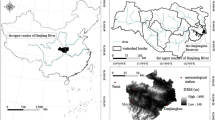Abstract
Quantitatively estimating soil erosion with an integration of geographic information system (GIS) and the revised universal soil loss equation (RUSLE) under four different exposed soil proportion scenarios caused by forest management practices was studied at Jianchang Forest Farm. The GIS provided means of input data generation required by RUSLE model and allowed a spatial assessment of the erosion hazard over the study area. Four exposed soil proportion scenarios of 5%, 10%, 20% and 30% were tested with the GIS-based RUSLE model to evaluate soil erosion hazard. The predicted soil erosion potentials were classified into five categories in order to provide valuable aids for management planning.
Similar content being viewed by others
References
Dissmeyer G E, Stednick J D. Drinking water from forests and grasslands: a synthesis of the scientific literature, general technical report SRS-39. North Carolina: USDA Forest Service, 2000. 109–139
Yan J Z, Zhang Y L, Bai W Q, et al. Land cover changes based on plant successions: deforestation, rehabilitation and degeneration of forest in the upper Dadu River watershed. Sci China Ser D-Earth Sci, 2005, 48(2): 2214–2230
Chen H, Zhou J X, Cai Q G, et al. The impact of vegetation restoration on erosion-induced sediment yield in the middle Yellow River and management prospect. Sci China Ser D-Earth Sci, 2005, 48(6): 724–741
Ryan P J, Murphy S, McKenzie N J. Assessing soil erosion hazard for Australian forest management. Victoria: Australia, Department of Agriculture Fisheries & Forestry, 2001. 14
Wischmeier W H, Smith D D. Predicting rainfall erosion losses—a guide to conservation planning. Agricultural Handbook. Washington, DC: USDA Science and Education Administration, 1978. 537
Millward A A. Adapting the RUSLE to model soil erosion potential in a mountainous tropical watershed. Catena, 1999, 38: 109–129
Jia T J. Soils of Liaoning (in Chinese). Shenyang: Liaoning Science and Technology Publishing House, 1992. 117–213
Renard K G, Foster G R, Weesies G A, et al. Predicting soil erosion by water: a guide to conservation planning with the Revised Universal Soil Loss Equation. Handbook No. 703. Washington, DC: U.S. Department of Agriculture, 1997. 404
Desmet P J, Govers G. A GIS-procedure for the automated calculation of the USLE LS-factor on topographically complex landscape units. J Soil Water Conserv, 1996a, 51(5): 427–433
Chen M H, Zhou F J, et al. Effects of slope gradient and slope length on soil erosion. J Soil Water Conserv (in Chinese), 1995, 9(1): 31–36
Dissmeyer G E, Foster G R. A guide for predicting sheet and rill erosion on forested land, technical publication SA-TP 11. West Lafayette: USDA Forest Service, 1980. 40
Dissmeyer G E, Foster G R. Estimating the cover management factor in the USLE for forest conditions. J Soil Water Conserv, 1981, 36(4): 235–240
Martinez R, L M. Educator/Professor with IMECBIO, Universidad de Guadalajara, Personal Correspondence, July 15 to August 15, 1997
Huang Y, Jia T H, et al. Quantitative study of soil erosion on tussore ground in Liaoning Province. Liaoning Urban and Rural Environmental Science & Technology (in Chinese), 2000, 20(4): 14–16
Zhang Y L, Huang Y, et al. Quantitative study of soil erosion on slope-land in Liaoning Province. J Soil Water Conserv (in Chinese), 2002, 16(1): 13–15
Guo Y Y, Duan Q F, et al. Standards for Classification and Gradation of Soil Erosion (in Chinese). Beijing: China Water Resources and Hydropower Press, 1997
Swank W T, DeBano LF, Nelson D. Effects of timber management practices on soil and water. In: Burns R L, ed. Tech. Comp, National Forest System. Gen, Tech, Rep, WO-55. Washington, DC: U.S. Department of Agriculture, Forest Service, 1989. 180
Liu M, Hu Y M, et al. Quantitative study of forest soil erosion based on GIS, RS and RUSLE—a case study of Huzhong region, Da Hinggan Mountains. Res Soil Water Conserv (in Chinese), 2004, 11(3): 21–24
Tang L N, Wang Q L, G F Shao, et al. Digitally determining forest inventory units with an ecological classification system. Sci China Ser E, 2006, 49(supp.I): 118–127
Author information
Authors and Affiliations
Corresponding author
Rights and permissions
About this article
Cite this article
Zhang, H., Wang, Q., Dai, L. et al. Quantifying soil erosion with GIS-based RUSLE under different forest management options in Jianchang Forest Farm. SCI CHINA SER E 49 (Suppl 1), 160–166 (2006). https://doi.org/10.1007/s11434-006-8117-z
Received:
Accepted:
Issue Date:
DOI: https://doi.org/10.1007/s11434-006-8117-z




